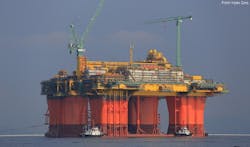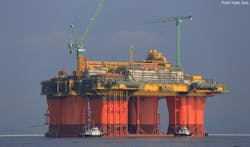The central processing facility (CPF) for the Inpex Corp.-Total SA joint venture’s Ichthys gas-condensate field in the Browse basin offshore Western Australia has been successfully launched from its dry dock construction site in South Korea. In April, contractors completed the first topside module lifts onto the CPF and the floating production, storage, and offloading facility (OGJ Online, Apr. 24, 2015).
The CPF was launched from the offshore floating dock at Samsung Heavy Industries’ shipyard in Geoje and is now berthed at the shipyard’s quayside where work is continuing to lift and install the living quarters. This will be followed by integration and commissioning of all the onboard equipment in preparation for the tow to the Ichthys location.
The column-stabilized CPF is a major component of the Ichthys gas, condensate, and LNG project as it will support the processing systems and utilities and provide accommodation for about 200 personnel.
When construction is complete the CPF will be towed 5,600 km to the field, about 225 km offshore Western Australia. It will be permanently moored using 28 mooring lines and 25,000 tonnes of anchor chain. It will remain on location for the projected 40-year life of the field.
Gas and condensate will undergo initial processing on the facility to separate condensate, water, and other impurities from the gas stream. The treated gas will then be transported by subsea pipeline some 890 km to the Darwin LNG plant in the Northern Territory.
The bulk of the condensate will be transferred to a nearby FPSO for direct export, but some condensate will be left in the gas for the transfer to Darwin.
The project is expected to produce 8.4 million tonnes/year of LNG, 1.6 million tpy of LPG, and 100,000 b/d of condensate.
The project now is expected to come on stream during third-quarter 2017.



